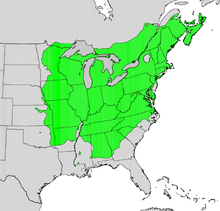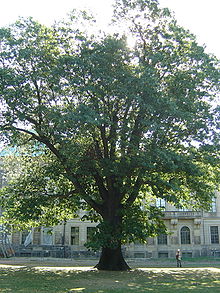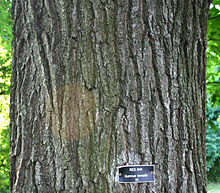- Quercus rubra
-
Quercus rubra An old Northen Red Oak specimen Conservation status Scientific classification Kingdom: Plantae (unranked): Angiosperms (unranked): Eudicots (unranked): Rosids Order: Fagales Family: Fagaceae Genus: Quercus Section: Lobatae Species: Q. rubra Binomial name Quercus rubra
L.
Quercus rubra, commonly called northern red oak or champion oak, (syn. Quercus borealis), is an oak in the red oak group (Quercus section Lobatae). It is a native of North America, in the northeastern United States and southeast Canada. It grows from the north end of the Great Lakes, east to Nova Scotia, south as far as Georgia and states with good soil that is slightly acidic. Often simply called "red oak", northern red oak is formally so named to distinguish it from southern red oak (Q. falcata), also known as the Spanish oak.
Contents
Description
In forests, the northern red oak grows straight and tall, to 28 m (90 ft), exceptionally to 43 m (140 ft) tall, with a trunk of up to 50-100 cm (20-40 in) diameter. Open-grown trees do not get so tall, but can develop a stouter trunk, up to 2 m (6 ft) in diameter. It has stout branches growing at right angles to the stem, forming a narrow round-topped head. It grows rapidly and is tolerant of many soils and varied situations, although it prefers the glacial drift and well-drained borders of streams.[2] It is frequently a part of the canopy in an oak-heath forest, but generally not as important as some other oaks. [3][4]
Under optimal conditions, northern red oak is fast growing and a 10-year-old tree can be 5-6 m (15-20 ft) tall.[5] Trees may live up to 500 years according to the USDA,[6] and a living example of 326 years was noted in 2001 by Orwig et al.[7]
Northern red oak is easy to recognize by its bark, which feature bark ridges that appear to have shiny stripes down the center. A few other oaks have bark with this kind of appearance in the upper tree, but the northern red oak is the only tree with the striping all the way down the trunk.
- Bark:Dark reddish grey brown, with broad, thin, rounded ridges, scaly. On young trees and large stems, smooth and light gray. Rich in tannic acid. Branchlets slender, at first bright green, shining, then dark red, finally dark brown. Bark is brownish gray, becoming dark brown on old trees.
- Wood: Pale reddish brown, sapwood darker, heavy, hard, strong, coarse-grained. Checks in drying, but when carefully treated could be successfully used for furniture. Also used in construction and for interior finish of houses. Sp. gr., 0.6621; weight of cu. ft., 41.25 lbs.
- Winter buds: Dark chestnut brown (reddish brown), ovate, acute, generally 6 mm long
- Leaves: Alternate, seven to nine-lobed, oblong-ovate to oblong, five to ten inches long, four to six inches broad; seven to eleven lobes tapering gradually from broad bases, acute, and usually repandly dentate and terminating with long bristle-pointed teeth; the second pair of lobes from apex are largest; midrib and primary veins conspicuous. Lobes are less deeply cut than most other oaks of the red oak group (except for black oak[disambiguation needed
 ] which can be similar). Leaves emerge from the bud convolute, pink, covered with soft silky down above, coated with thick white tomentum below. When full grown are dark green and smooth, sometimes shining above, yellow green, smooth or hairy on the axils of the veins below. In autum they turn a rich red, sometimes brown. Often the petiole and midvein are a rich red color in midsummer and early autumn, though this is not true of all red oaks. Petioles year, about 18 months after pollination; solitary or in pairs, sessile or stalked; nut oblong-ovoid with broad flat base, full, with acute apex, one half to one and one-fourth of an inch long, first green, maturing nut-brown; cup, saucer-shaped and shallow, 2cm (0.8 in) wide, usually covering only the base, sometimes one-fourth of the nut, thick, shallow, reddish brown, somewhat downy within, covered with thin imbricated reddish brown scales. Kernel white and very bitter.[2] Despite this bitterness, they are eaten by deer, squirrels and birds.
] which can be similar). Leaves emerge from the bud convolute, pink, covered with soft silky down above, coated with thick white tomentum below. When full grown are dark green and smooth, sometimes shining above, yellow green, smooth or hairy on the axils of the veins below. In autum they turn a rich red, sometimes brown. Often the petiole and midvein are a rich red color in midsummer and early autumn, though this is not true of all red oaks. Petioles year, about 18 months after pollination; solitary or in pairs, sessile or stalked; nut oblong-ovoid with broad flat base, full, with acute apex, one half to one and one-fourth of an inch long, first green, maturing nut-brown; cup, saucer-shaped and shallow, 2cm (0.8 in) wide, usually covering only the base, sometimes one-fourth of the nut, thick, shallow, reddish brown, somewhat downy within, covered with thin imbricated reddish brown scales. Kernel white and very bitter.[2] Despite this bitterness, they are eaten by deer, squirrels and birds.
Uses
The northern red oak is one of the most important oaks for timber production in North America. The wood is of high value. Other related oaks are also cut and marketed as red oak, although their wood is not always of as high a quality. These include eastern black oak, scarlet oak, pin oak, Shumard oak, southern red oak and other species in the red oak group. Construction uses include flooring, veneer, interior trim, and furniture.
Red oak wood grain is so open that smoke can be blown through it from end-grain to end-grain on a flat-sawn board. For this reason, it is subject to moisture infiltration and is unsuitable for outdoor uses such as boatbuilding or exterior trim.
Famous specimens
- Ashford Oak - A very large Northern Red Oak in Ashford, Connecticut. The tree has suffered falling limbs because of its great age. However, this tree is still a sight to behold; the trunk is 8 m (26 feet) in girth and the root-knees are also particularly impressive. The oak is located on Giant Oak Lane off U.S. Highway 44. There are several other large oaks in the area.[8]
- Chase Creek Red Oak - This forest tree is located on a very rich steep slope in Anne Arundel County, Maryland. It is a high-stump coppice with three leads. It was the state champion oak in Maryland in 2002. The circumference at breast height is 6.7 m (22 feet), the height 41.5 m (136 feet) and the spread 29.9 m (98 feet)[8]
References
- ^ NatureServe (2006), "Quercus rubra", NatureServe Explorer: An online encyclopedia of life, Version 6.1., Arlington, http://www.natureserve.org/explorer/servlet/NatureServe?searchName=Quercus+rubra+, retrieved 2007-06-13
- ^ a b Keeler, Harriet L. (1900). Our Native Trees and How to Identify Them. New Roak: Charles Scriber's Sons. pp. 349–354.
- ^ The Natural Communities of Virginia Classification of Ecological Community Groups (Version 2.3), Virginia Department of Conservation and Recreation, 2010
- ^ Schafale, M. P. and A. S. Weakley. 1990. Classification of the natural communities of North Carolina: third approximation. North Carolina Natural Heritage Program, North Carolina Division of Parks and Recreation.
- ^ http://www.arborday.org/trees/treeGuide/TreeDetail.cfm?id=20>
- ^ http://plants.usda.gov/plantguide/pdf/cs_quru.pdf
- ^ Eastern US oldlist
- ^ a b Rucker, Colby B. (February), Great Eastern Trees, Past and Present, http://www.nativetreesociety.org/bigtree/great_eastern_trees.htm, retrieved 2007-05-05
External links
Categories:- NatureServe Secure species
- Quercus
- Trees of the Eastern United States
- Trees of Ontario
- Flora of the Northeastern United States
- Flora of the Great Lakes region (North America)
- Flora of the North-Central United States
- Flora of Appalachia (United States)
- Flora of Delaware
- Flora of Kentucky
- Flora of Maryland
- Flora of Massachusetts
- Flora of Michigan
- Flora of Pennsylvania
- Flora of Virginia
- Flora of Washington, D.C.
- Flora of West Virginia
- Flora of Tennessee
- Trees of Alabama
- Trees of North Carolina
- Trees of Ohio
- Trees of the Southeastern United States
- Trees of humid continental climate
Wikimedia Foundation. 2010.



